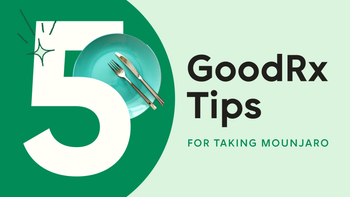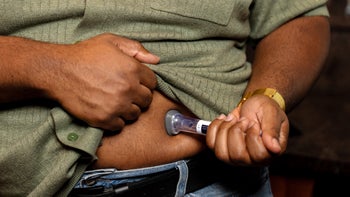
Is Compounded Tirzepatide Safe? 8 Things to Know About Mounjaro and Zepbound Knock-Offs
Key takeaways:
Compounded tirzepatide isn’t an exact match to FDA-approved Mounjaro or Zepbound. It’s not regulated like the commercially available versions and hasn’t been evaluated for safety or effectiveness.
Compounded tirzepatide grew in popularity while Mounjaro and Zepbound were in shortage. In October 2024, the FDA determined that this shortage was resolved. And the FDA upheld this decision in December 2024 after it was challenged.
The FDA gave pharmacies deadlines to phase out compounded tirzepatide injections. These deadlines have since passed. Pharmacies are no longer allowed to regularly compound tirzepatide injections, except in limited circumstances involving medical need.
Unauthorized and counterfeit tirzepatide are being sold. These are illegal and can pose serious health risks. You should avoid purchasing tirzepatide that’s being sold without a prescription.
Table of contents

Compounding pharmacies play an important role in helping people access their medications. For instance, they can be helpful if a person needs a different dosage form than what’s commercially available. They’re also useful when it comes to helping people navigate drug shortages.
Sometimes, the FDA allows pharmacies to compound a medication that’s in short supply. But when demand is high, it’s also possible for unsafe compounded and counterfeit products to end up in people’s hands. This has been the case for tirzepatide, the active ingredient in Mounjaro and Zepbound.
But tirzepatide is no longer in shortage. So compounded versions are mostly being phased out. That being said, compounded tirzepatide hasn’t completely gone away. But you should understand the potential risks if you’re thinking about trying it. Below are eight things to keep in mind if you’re considering trying compounded tirzepatide.
Save every month on GLP-1 meds with GoodRx
Save an average of $235 on FDA-approved GLP-1s like Ozempic and Zepbound.

1. The FDA determined that the Mounjaro and Zepbound shortages are over
Due to its high demand and short supply, the FDA determined that there was a shortage of Mounjaro in December 2022. And a few months after the FDA approved Zepbound for weight loss, it was in shortage, too. During this time, many people turned to compounded tirzepatide because they couldn’t otherwise access the medications.
But in October 2024, the FDA finally determined that the tirzepatide shortage was resolved. When a drug shortage ends, that means pharmacies are no longer allowed to regularly compound that medication with limited exceptions, such as an allergy to an inactive ingredient. Cost isn’t considered a reason to compound commercially available medications.
This decision was challenged shortly after the agency’s announcement. The FDA agreed to reevaluate the shortage’s status. In December 2024, the agency upheld its original decision.
After their final ruling, the FDA provided grace periods for compounding pharmacies to stop production of compounded tirzepatide injections. Those grace periods have since ended. This means that compounding pharmacies should no longer be making tirzepatide products, except in limited circumstances involving medical need.
2. Compounded tirzepatide is not the same as Mounjaro or Zepbound
Both Mounjaro and Zepbound are FDA-approved medications. In order to be approved, a medication has to go through rigorous tests and reviews. This helps the FDA ensure that it’s safe and effective for certain health conditions and populations. During this process, the FDA also inspects where and how the medication is manufactured.
On the other hand, compounded medications aren’t required to go through the FDA’s approval process. They’re custom-made by combining pharmaceutical-grade active ingredients with various inactive ingredients. This can be helpful in some cases, such as when you need to avoid a substance due to allergies. But there are also unique risks involved.
Beyond FDA approval, there are other key differences between commercially available and compounded tirzepatide:
Ingredients: All of the active and inactive ingredients are listed in Mounjaro’s and Zepbound’s labeling. This is standardized, and you can expect it to be the same for every injection. Pharmacies compounding tirzepatide follow a recipe to make the medication. Compounded versions can vary when it comes to the types and amounts of inactive ingredients used.
Medication delivery: Most people receive Mounjaro or Zepbound as single-use injection pens. Vials of the medications are also made by Eli Lilly (the manufacturer). Compounded tirzepatide injections are typically dispensed as vials. Some compounded tirzepatide products come in oral forms, such as tablets. There haven’t been clinical studies showing that these forms are safe or effective, or what a typical dosage may be.
Storage: Mounjaro and Zepbound have standard storage requirements. Compounded tirzepatide’s recommended storage instructions depend on how the product is made. And these recommendations may differ between compounding pharmacies.
Mounjaro alternatives: Due to increased demand, it may be difficult to find Mounjaro. Depending on your treatment goals and other factors, your prescriber may consider switching you to one of these Mounjaro alternatives.
What does Mounjaro look like? Knowing what Mounjaro looks like can help you identify potential counterfeit products.
All about compounding: Pharmacists review the ins and outs of compounding pharmacies and the role they play in making medications accessible.
If you’re switching from compounded tirzepatide to FDA-approved Mounjaro or Zepbound, take note of these differences. Be sure to review how you should store them, what their expiration dates are, and how to inject your doses.
3. If someone is selling tirzepatide without a prescription, it’s not legitimate
Tirzepatide is a prescription-only medication. This includes Mounjaro, Zepbound, and compounded tirzepatide. To obtain it, a licensed healthcare professional will need to send a prescription for it to a pharmacy.
Avoid purchasing tirzepatide from someone who claims you can get it without a prescription. In many cases, it’s sold as “research-grade” tirzepatide. This isn’t approved, authorized, or regulated by the FDA. And this form of tirzepatide isn’t intended for human use.
Read more like this
Explore these related articles, suggested for readers like you.
4. Pharmacies may be using unauthorized forms of tirzepatide
When a pharmacy compounds a medication, it must get the active ingredient from an FDA-registered supplier. This helps ensure the authenticity of the active ingredient included in a compounded medication.
Eli Lilly has stated that it doesn’t supply bulk tirzepatide to facilities other than those that it owns and operates. But the FDA does list several registered suppliers on its website. However, it’s possible that some pharmacies may be obtaining their bulk tirzepatide from an unregistered supplier. And if they're doing this, there’s a greater risk of quality and safety issues.
5. Only certain pharmacies can compound injectable medications
Even if pharmacies are sourcing legitimate tirzepatide, there are extra steps needed before they can legally compound it. When a pharmacy compounds injectable medications, it needs to be done in a sterile environment. This helps lower the risk of contamination.
Compounding pharmacies are regulated by state Boards of Pharmacy. Some states require these pharmacies to obtain certain licenses or certifications in order to compound sterile medications. But compounding regulations and the degree of oversight required can vary from state to state. There are also outsourcing facilities, which are compounding pharmacies that are registered with the FDA. Outsourcing facilities are inspected by the FDA and must meet more stringent requirements.
Some pharmacies may obtain accreditation that is specific to compounded medications. Accreditation is optional, but it shows that a pharmacy has met a specific set of quality and safety standards for compounding.
The quality of the medication that you receive can depend on the compounding pharmacy that fills your prescription. For an added layer of reassurance, there are ways to find out if a pharmacy or pharmacist is certified or accredited to perform sterile compounding.
The National Association of Boards of Pharmacy (NABP): You can submit an online form to NABP with the pharmacy’s name and location. NABP will respond to you with details regarding whether it has accredited the pharmacy for compounding and if it’s in good standing.
Pharmacy Compounding Accreditation Board (PCAB): You can search for compounding pharmacies that are accredited by PCAB using its online tool. Be sure to select “PCAB Compounding Pharmacy” from the drop-down menu where it says “Select Your Program.” Then, choose the “PCAB Sterile Compounding” option from the filter option titled “Select a service.” You can then filter the results by your location.
Board of Pharmacy Specialists (BPS): Pharmacists who regularly perform sterile compounding may be board-certified to do so. Using BPS’ online tool, you can search for pharmacists who are certified in your state. Just make sure to select the “Compounded Sterile Preparations Pharmacy” from the list of specialties.
The Joint Commission: You can contact The Joint Commission to verify a pharmacy’s Medical Compounding Certification by submitting an online form. Many states are in the process of making this certification a requirement for compounding pharmacies.
Good to know: Healthcare professionals that frequently prescribe compounded medications are often familiar with compounding pharmacies in their area. Consider asking your prescriber for recommendations on a pharmacy that they trust.
6. Counterfeit tirzepatide is out there, and it poses safety risks
The existence of counterfeits is another issue when it comes to purchasing a tirzepatide product that’s not Mounjaro or Zepbound. These fake products, which are often sold online, can pose more risks than tirzepatide made by a compounding pharmacy.
Some safety issues that can happen with counterfeit tirzepatide include:
The product may contain too high or too low of a dose of tirzepatide.
The product may not contain any medication at all.
The product may contain another medication, such as insulin.
The product could be contaminated with germs, such as bacteria or fungi.
The medication you receive could be expired.
The device you use to inject yourself could malfunction and hurt you.
There are steps you can take to verify if you’ve received legitimate Mounjaro or Zepbound. A good place to start is to check your product against images from the manufacturer. Other steps you can take include:
Scan the barcode on your product. Lilly has a barcode scanning tool online. Using your phone’s or computer’s camera, scan the barcode on your product. The tool will tell you if it's authentic Mounjaro or Zepbound.
Check the box that the medication comes in. Look for the brand name, concentration (written as mg/mL), and a National Drug Code (NDC) number. You can verify whether an NDC is real at the FDA’s NDC directory website.
Check the labels on your pens or vials. These should also have the brand name, concentration, and an NDC on them. The NDC may be slightly different from what’s on the box. But you should still be able to verify it on the FDA’s database.
If you’re using Mounjaro or Zepbound pens, check for a purple injector button that doesn’t extend. The pen shouldn’t require you to dial up a dose or attach a pen needle before you use it.
If you’re ever in doubt as to whether your product is legitimate, you can verify it with the manufacturer by calling 1-800-545-5979.
7. Cheaper doesn’t mean better
Compounded tirzepatide is often marketed as a lower-cost alternative to Mounjaro or Zepbound. But as discussed above, there are risks and unknowns involved with using it. In some cases, a lower price tag could mean that lower-quality ingredients were used while producing it.
Plus, pharmacies are only allowed to compound tirzepatide in certain cases, such as to avoid an inactive ingredient due to an allergy. The FDA doesn’t consider cost a reason for someone to receive a compounded medication when the FDA-approved product is available.
If medication costs are preventing you from accessing your medication, speak with your prescriber. There are lower-cost, FDA-approved alternatives available for both Mounjaro and Zepbound.
Tips for switching from compounded tirzepatide to brand-name Mounjaro or Zepbound
Most people are going to have to switch from compounded tirzepatide to an FDA-approved version. Making this switch may seem daunting. But there are steps you can take to help make the process smoother:
Talk to your healthcare team first. Your prescriber can help you decide if Mounjaro, Zepbound, or another similar medication is your best option. They’ll also need to send a new prescription for it to your pharmacy.
Contact your insurance plan. Insurance coverage varies for these medications. And they may require extra steps, such as a prior authorization, before they’ll cover them. Call your insurance plan for details on which medication(s) they cover and expected costs.
Check for savings opportunities. Both Mounjaro and Zepbound have manufacturer copay cards available. If you have commercial insurance, these cards can help lower your prescription costs. And be sure to check GoodRx for other savings opportunities.
Call the pharmacy for refills early. It’s a good idea to contact your pharmacy for refills at least a week in advance. This gives them time to order your medication, so you can avoid delays when you run out.
Consider LillyDirect for Zepbound. Lilly offers vials of Zepbound directly through their website (called LillyDirect). This can help ensure that your medication is available when you need it. And it can help lower costs if your insurance plan doesn’t cover Zepbound. Lower-cost single-dose vials are available through LillyDirect for $349 (2.5 mg) and $499 (5 mg, 7.5 mg, and 10 mg) per month.
The bottom line
Until October 2024, tirzepatide was being widely compounded because there was a shortage of Mounjaro and Zepbound — the FDA-approved versions of tirzepatide. The FDA has determined that the tirzepatide shortage has been resolved. So pharmacies are no longer allowed to widely compound the medication, with limited exceptions based on medical need.
Compounded tirzepatide isn’t the same as Mounjaro or Zepbound. Its safety and effectiveness haven’t been evaluated. And it may contain different inactive ingredients and have different storage requirements than commercially available medications.
When it comes to compounded tirzepatide, it can be hard to tell if the product you buy is safe and effective or a counterfeit. Avoid purchasing tirzepatide that’s sold without a prescription, as this is likely an unauthorized version of the medication.
If you’re switching from compounded tirzepatide to Mounjaro or Zepbound, speak with your healthcare team first. They can help make the transition smoother.
Why trust our experts?


References
American Society of Health-System Pharmacists. (2013). ASHP guidelines on compounding sterile preparations.
Eli Lilly and Company. (2024). An open letter from Eli Lilly and Company regarding certain practices related to Mounjaro and Zepbound.
Eli Lilly and Company. (2024). Lilly warns patients about counterfeit and compounded medicines releases open letter and takes further legal action against counterfeit, fake, unsafe, and untested products.
Eli Lilly and Company. (2025). Lilly launches additional Zepbound vial doses and offers new savings for self-pay patients.
Eli Lilly and Company. (2025). Mounjaro- tirzepatide injection, solution [package insert].
Eli Lilly and Company. (2025). Zepbound- tirzepatide injection, solution [package insert].
Endocrine Today. (2024). FDA issues warnings to two companies for unapproved semaglutide, tirzepatide. Healio.
U.S. Food and Drug Administration. (2017). National Drug Code database background information.
U.S. Food and Drug Administration. (2022). Information for outsourcing facilities.
U.S. Food and Drug Administration. (2022). New Drug Application (NDA).
U.S. Food and Drug Administration. (2023). FDA approves new medication for chronic weight management.
U.S. Food and Drug Administration. (2024). Compounding when drugs are on FDA’s drug shortages list.
U.S. Food and Drug Administration. (2024). FDA drug shortages.
U.S. Food and Drug Administration. (2025). Facts about the Current Good Manufacturing Practice (CGMP).
U.S. Food and Drug Administration. (2025). FDA clarifies policies for compounders as national GLP-1 supply begins to stabilize.
U.S. Food and Drug Administration. (2025). FDA’s concerns with unapproved GLP-1 drugs used for weight loss.





























